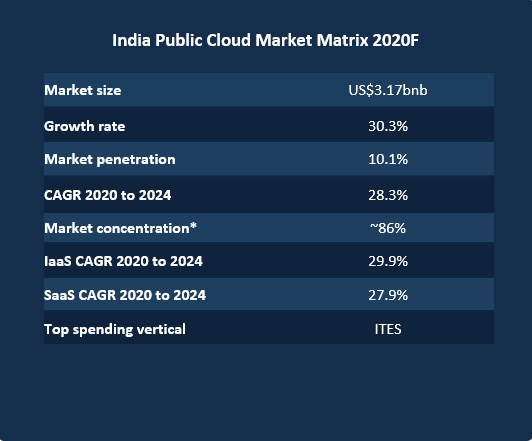Research highlights:
- Public Cloud spending accounts for approximately 3.5% of the total IT spend in India.
- Software-as-a-Service (SaaS) was the biggest segment of cloud services in 2020. It accounted for over 50% of the total public cloud revenue.
- Notable cloud contracts were witnessed in IT/ITES & the manufacturing industry that respectively accounted for 25% and 15% of total revenues.
- BFSI adoption of the cloud has been poor due to regulatory issues and concerns around security
Market Drivers
Irrespective of their scales of operations, businesses in India are shifting from standalone and in-house-based infrastructures to cloud-based deployments. While there is still demand for colocation and shared or private infrastructure deployments, an increased awareness of the cloud has spurred its public sector adoption by large enterprises.
- Start-up ecosystem – As of 2020, there were around 55,000 startups in India, of which nearly 20% are tech based. These digital start-ups have no legacy infrastructure at place and have an increased need for storage and computing. Cloud deployments enable start-ups to build highly elastic and scalable businesses whilst optimizing costs.
- Digital government Initiatives–The Government of India (GOI) has shared a comprehensive Digital India roadmap which covers various segments that would be touched upon in order to achieve holistic digitization. Some of the prominent initiatives that have had a huge impact on the spending on cloud is “Meghraj” which is the ‘GI cloud’ – an environment hosted by the government for its state and central departments. GOI plans to allocate US$ 5 billion for creating 109 smart cities/provinces across the nation by 2022. These initiatives lay down a strong foundation for the deployment and the use of cloud in the coming years.
- Well-developed ecosystem– The focus on digital literacy in universities has led to graduates showing active interest in pursuing and building their capabilities in the cloud. Over time, this has led to an increased awareness of cloud and has thus had a positive cascading impact on the availability of skilled labor. When augmented with a network infrastructure capable enough to deliver applications, it can encourage various businesses to shift to the cloud service models. With the advent of 5g and use cases that already demand its availability, for example, Smart factories and autonomous cars, cloud is slowly becoming a standard and not just an alternative.
- IT/ITES & Manufacturing migration to cloud – Both industries combined contribute nearly 40% to the overall cloud revenues. ITES has been at the forefront of cloud adoption, owing to the pandemic. Manufacturing is a steady contributor to cloud ERP services revenue in India. The integration of ICT technologies like AI & IoT within business processes of large manufacturing companies has also significantly increased. Large scale manufacturers like Tata Motors led the adoption of public cloud for process efficiency and productivity increment as early as 2015, it paved the way for the manufacturing industry to adopt SAAS and IAAS.
Trends by key verticals
- IT/ITES – India’s IT industry is the world’s largest talent pool of technology graduates in the world. It accounts for close to 8 percent of the GDP of the country. It is the single biggest vertical for cloud spending and currently accounts for 25% of the total market share and it is expected to maintain this share in forthcoming years. Growth in domestic business is another key demand driver for this sector.
- Government & Public sector – The government spending has been on a growth trajectory driven by the digital India initiative under the PMO. However, it has now been impacted by the pandemic and with a rise in fiscal deficits and a liquidity crunch. Government spending amounts to only 8% of the total spend. This will change as the government revives itself in a post-pandemic era.
- Manufacturing – Manufacturing accounts for 15% of the total spend on public cloud in India. Though the manufacturing industry grew at a CAGR of 5.8% between 2016 to 2019 the industry witnessed a contraction due to the ongoing pandemic in 2020. The GOI has taken several initiatives to boost the local consumption in the economy. For example, it has given significant incentives to central government employees through various channels to accelerate internal consumption which would have a cascading positive impact on manufacturing industry. 5G implementation could give rise to connected and even autonomous cars. This will impact the digitization of the sector as well as growth in the adoption of public cloud infrastructure and software.
Market Development Opportunities
- Surge in E-commerce Spending – India’s e-comm sector is expected to continue its strong growth trajectory. Many of these leaders are considering a multi-cloud strategy and this provides an opportunity to new entrants.
- Manufacturer Migration to Cloud – India is one of the largest manufacturing hubs in Asia and has been leading adopters of a number of SaaS offerings. As more manufacturers demand efficiency and automation, they will start migrating more of their applications to the cloud.
- Growth of Logistics Companies – E-commerce growth has been a key driver for the growth of the logistics industry. The existing players need to scale rapidly and are digitizing their operations. It is also attracting several new participants which augurs well for the overall adoption of cloud in this industry.
- Increase in High Quality Gaming – The pandemic was a key driver for the growth of the gaming industry in the country. There are an estimated 350 million online gamers in the country and this number is expected to cross 500 million by 2022. Cloud solutions are a natural choice for gaming companies who seek elasticity and pay on consumption models to support their growth strategy.

